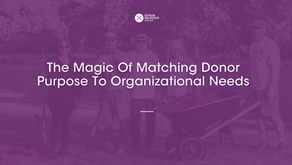Annual Giving and Donor Relations – the Dream Team
- Lynne Wester

- Sep 3, 2024
- 3 min read

Do you know what we love most about our colleagues in annual giving? Besides the fact that they tend to be the most fun group in a development shop (next to donor relations, of course)—we love that they never seem satisfied with “sameness.”
Annual giving is always looking for a new way to connect with our donors. They try all the approaches or what they call a “multi-channel” approach to communicating. They test ideas and see which has the better outcome. They look at data to make all their decisions. They survey their audiences to learn more about what makes them tick. Then they personalize messages and approaches for donors based on what they have learned.
This is what a great donor relations team should also be striving to do. Donor relations teams want to find the best way to connect with their donors—in a way that is personal and meaningful to the donors. They use many different communication channels. They collect important intel on donors. They cultivate and use their data to make decisions. And, they have a plan for who to reach out to, when and what information is important.
Both teams, annual giving and donor relations, want to build relationships with our donors, and we both care about donor retention. We pay attention to donor loyalty. We seek to find a message that resonates with our donors and inspires them into action. We create systems to streamline our work so it will be more effective.
Our two teams focus on the donor pipeline—we want to identify, engage, and build long-lasting relationships with our donors through carefully planned interactions and donor touches. We are talking about a “dream team”—annual giving and donor relations. Together, we are responsible for the long-term health of our organizations.
Here are a few tips for how we can work together most successfully:
Share goals - there are so many goals we set each year, and often these goals overlap. For example, UC Davis just ended a comprehensive campaign, and we have thousands of new donors, so together our teams are focusing on retention.
Share resources - our annual giving team is having huge success with texting donors, so they suggested we try using their platform to communicate an important impact message this year.
Share calendars - our teams send the bulk of our donor messages, so we coordinate our mailings; therefore, they complement and do not compete with each other.
Share data – both teams gather data and feedback from our donors and prospects. We make a point to share this data so both teams can be more successful. For example, we hosted a virtual event that drew nearly 1000 attendees. At the end of the event, we surveyed attendees to ask if they wanted to learn more, and if they were interested in donating to this area. The response to this event, and the data gathered after the event helps us as well as our annual giving team.
Share talent – these two teams are made up of some of the most creative people in our organization. When we want to ideate or brainstorm, we ask these team members to join us. When we need a good editor, we ask this team.
When it comes down to it, donor relations and annual giving are really the lifeblood of our organizations. If we strategically work together, then both teams are even more successful. When we share our goals, resources, calendars, data and talent—that is when the magic happens.
Written by Angie Joens





